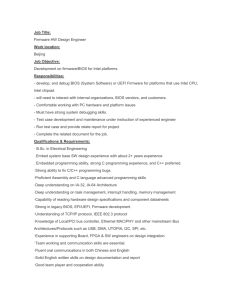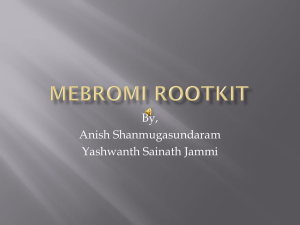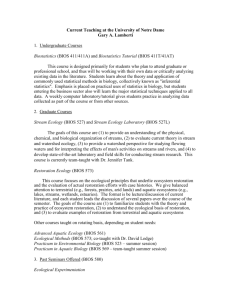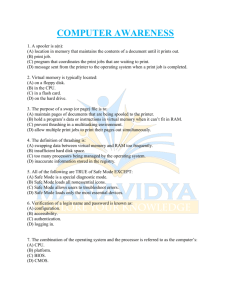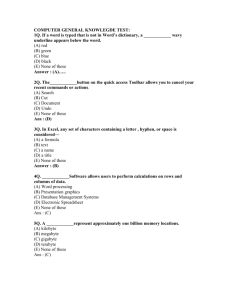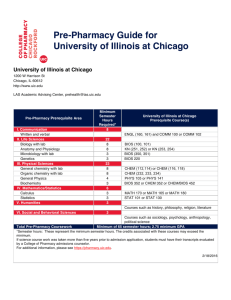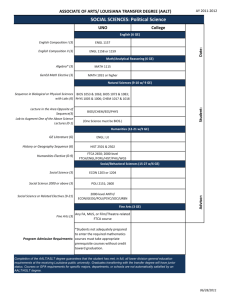BIOS (Basic Input Output Service)
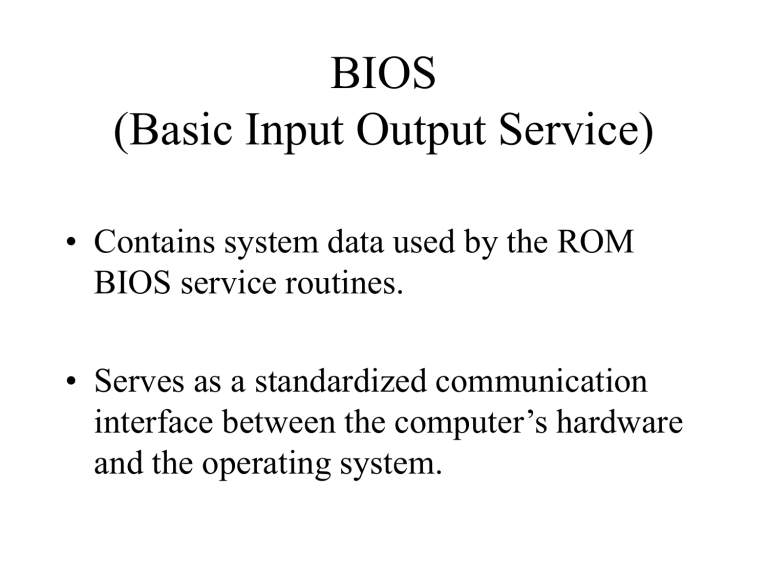
BIOS
(Basic Input Output Service)
• Contains system data used by the ROM
BIOS service routines.
• Serves as a standardized communication interface between the computer’s hardware and the operating system.
BIOS
• Is a small ROM chip on the PC’s motherboard.
• A basic software program containing all BIOS functions is permanently stored in the ROM.
• This software functions as a basic operating system.
• Is responsible for starting the PC.
• This hardware integrated with software is also referred to as firmware .
BIOS History
• Intel developed the 8086 and 8088 in the end of the 70s.
• IBM decided to make an affordable computer out of the 8088.
• Microsoft created the operating system
(DOS).
DOS
(Disk Operating System)
Fundamentals
• Consisted of two parts
The BIOS itself is one part of the operating system.
The other part consists of the operating system program files.
– Program files consist of
• Utilities
• A kernel that is loaded into the main memory when the computer boots.
Cloning
• IBM introduced the complete PC with the operating system in 1981.
• IBM owned copyrights to the BIOS.
• IBM published all the assembly language source code for the IBM PC/XT BIOS.
• Peter Norton wrote the landmark book
Inside the IBM-PC.
• Microsoft made DOS available to other licensees.
Clones
• Compaq developed a BIOS by 1983. Also introduced their own PC.
• Phoenix Technologies released a BIOS package (IBM-compatible BIOS and a version of DOS).
• Manufacturers of today, such as AMI,
Award and MR-BIOS, all developed their own source code for an IBM-compatible
BIOS.
Functions of the BIOS
• When you first turn on your PC
– Your PC requires information
• to detect PC components
• To find the operating system(floppy disk, hard drive, or a CD-ROM)
– This information is stored in the BIOS
Flow Chart of BIOS Functions
Turn on Computer
Pass through POST Error Free
YE
S
Plug’n’Play
N
O
Test Boot Drive
Bootable media found
N
O
Load boot program
Output to Monitor
Pass through POST Error Free
Pass through POST Error Free
YE
S
Pass through POST Error Free
NO
Start operating system
POST
(Power On Self Test)
• Takes place right after you power on.
• Contains diagnostic routines for
– initializing the hardware and peripherals
• the video card, the main memory, the processor, the keyboard, etc.
– Checking their functions
• Error message on screen if an error is detected. If monitor cannot be detected, the beep codes are output by the system loud speaker.
Plug and Play
• Bios next looks for additional BIOS memory chips – might be on a Plug and
Play card such as video card or a SCSI controller.
– If present, they run their routines and supplement or replace some functions of the system BIOS.
• If components no longer match the data stored in the CMOS (i.e. hardware change), message appreas on screen to update.
Plug and Play
• After all hardware components have been found and checked, Plug and Play goes to work.
• Interrupts and DMA channels of the plug-in cards in the ISA and PCI buses are queried and distributed.
• Onboard hardware, located on motherboard and in its ISA/PCI slots, are configured for operation.
Bootstrap Loader
• BIOS next accesses the first sector of the hard drive, alos termed the boot sector, and starts the “bootstrap loader”
– A small program that knows the file structure of the storage medium and can call the operating system’s start routine.
Operating System Kernel
• Next, the operating system kernel is read into main memory and control of the hardware passes onto the operating system.
An Interpreter
• In old operating systems (DOS 6.2), the
BIOS acts as a mediator (or interface) between the hardware and the software.
• New operating systems, circumvent the
BIOS and communicate directly with the hardware through the appropriate drivers.
BIOS Updating
• The BIOS is manufactured on FLASH technology. It is easily updated.
• Previous versions of BIOS were developed on ROM, EPROM,and EEPROM chips.
DOS
(Disk Operating System)
Fundamentals
• Consisted of two parts
The BIOS itself is one part of the operating system.
The other part consists of the operating system program files.
– Program files consist of
• Utilities
• A kernel that is loaded into the main memory when the computer boots.
Microsoft Kernels
• Kernel of a Microsoft operating system consists of
– Msdos.sys
– Io.sys
• MSDOS.sys controls the keyboard input and the screen output.
• IO.sys communicates with the BIOS and contains the actual program code of the operating system and a process control for the hardware.
BIOS Data Area, at Segment
HEX OFFSET
0000 - 0007
0008 - 000F
0010 - 0011
0012
0013 - 0014
0015 - 0016
0017 -0018
0019
001A - 001B
001C - 001D
001E - 003D
003E - 0048
0049
004A - 004B
004C - 004D
004E - 004F
0050 - 005F
0060
0061
0062
0063 - 0064
0065
0066
0067 - 006B
006C - 0070
0040h
Description
Port addresses, COM1 - COM4
Port addresses, LPT1 - LPT4
Installed hardware list initialization flag memory size, in Kbytes
Memory in I/O channel keyboard status flags alternate key entry storage
Keyboard buffer pointer (head) keyboard buffer pointer (tail)
Keyboard typeahead buffer
Diskette data area
Current video mode
Number of screen columns
Regen buffer length, in bytes
Regen buffer starting offset
Cursor positions, video pages 1 -8
Cursor end line
Cursor start line
Currently displayed video page number
Active display base address
CRT mode register
Register for color graphics adapter
Cassette data area
Timer data area
Other BIOS chips in Your PC
• They have the same functionality as the system BIOS
– Control the corresponding device
• Contain software similar to the system
BIOS.
• Manufactured with FLASH technology to be upgraded easily.
Video BIOS-ROM
• Contains the basic data
– Initialization routines
– BIOS functions
– Character sets
• Initializes the registers of the VGA chip
• Sets the interrupt vectors for the interrupts
Video Interrupt
• There is a software interrupt that permits the software to communicate with the video card.
• INT 10h
• Can access the registers through it
• Can control the mode, character input/output, and read/write pixels.
